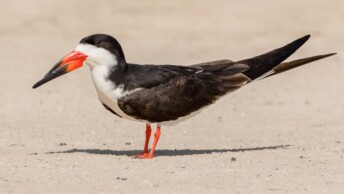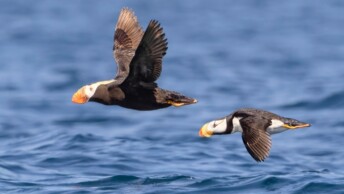The Andean condor is the world’s largest and heaviest living bird of prey, with a wingspan of up to 3.3 meters (10.8 feet) and a body mass reaching 15 kilograms (33.1 pounds). The secretarybird is the tallest and longest, standing 1.3 meters (4.3 feet) high and stretching 1.5 meters (4.9 feet) in length.
We begin with the biggest birds of prey overall and then turn to the largest representatives of each major raptor group, focusing on verified size records from wild individuals. These predatory birds dominate skies and open landscapes alike, each adapted to its ecological niche with power, endurance, and precision.
Andean Condor
Vultur gryphus
- Wingspan: As wide as 3.3 m (10.8 ft).
- Weight: As heavy as 15 kg (33.1 lb).
- Body length: Up to 130 cm (51.2 in).
- Where found: Along the Andes Mountains from Colombia to southern Chile and Argentina – in high-altitude grasslands, steppes, cliffs, and coastal zones.
- Conservation status: Vulnerable.
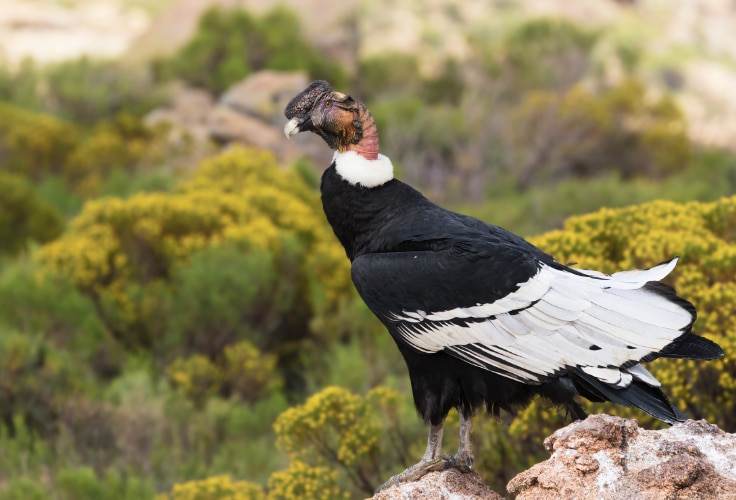
The Andean condor is the largest bird of prey in the world by combined wingspan and weight. With a wingspan reaching 3.3 meters (10.8 feet) and a maximum weight of 15 kilograms (33.1 pounds), it is uniquely adapted to soaring across vast mountain landscapes. Its massive wings, which have the greatest surface area of any flying bird, feature long, fingered primaries that exploit thermal updrafts, enabling it to glide for hours with minimal wingbeats.
This giant scavenger relies on carrion from large and medium-sized mammals, including guanacos, domestic and exotic livestock, and along coasts, stranded marine mammals. It also feeds opportunistically on eggs and seabirds, and its powerful bill tears through thick hides to reach muscle and viscera. Most feeding occurs during midday, often with many condors gathering at large carcasses, though dominant males rarely share. Their presence can even reduce the time pumas spend at their kills, indirectly pushing the predators to increase hunting frequency.
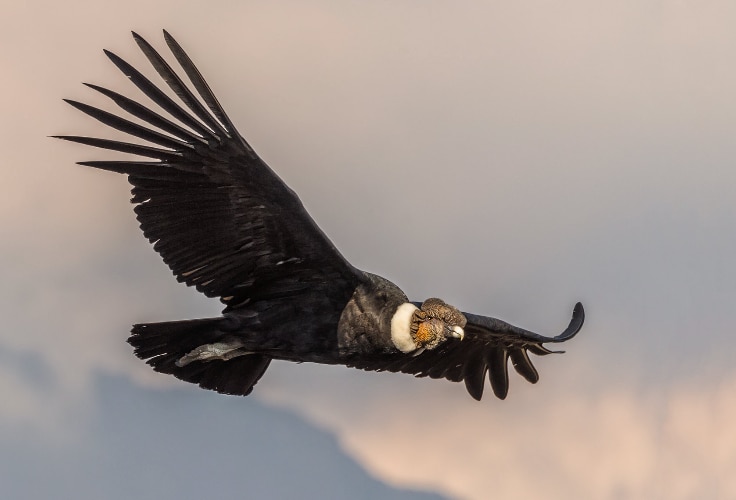
The species ranges along the entire Andean chain, from northern Colombia to southern Patagonia, occupying open alpine meadows, cliffs, temperate forests, and coastal deserts. It is increasingly scarce in the northern Andes, where reintroduction programs use rescued or captive-bred birds to restore local populations.
The Andean condor’s slow reproduction makes it vulnerable to human pressures. Threats include mass poisonings aimed at predators, lead ingestion from carcasses containing ammunition, and habitat loss to agriculture. It also faces persecution based on mistaken claims of livestock predation and growing competition from black vultures. Conservation measures involve satellite tracking, education campaigns, legal protections, and genetic monitoring, but long-term recovery depends on regional cooperation and effective mitigation of threats.
Cinereous Vulture
Aegypius monachus
- Wingspan: As wide as 3.1 m (10.2 ft).
- Weight: As heavy as 14 kg (30.9 lb).
- Body length: Up to 120 cm (47.2 in).
- Where found: Southern Europe through Central Asia to East Asia – in forested mountains, steppe, and arid highlands.
- Conservation status: Near Threatened.

The cinereous vulture, also known as the Eurasian black vulture, is the largest bird of prey in Europe and one of the heaviest in the world. With a wingspan reaching 3.1 meters (10.2 feet) and a body mass of up to 14 kilograms (30.9 pounds), it combines enormous bulk with soaring ability. Its massive, barn door-like wings, held straight or slightly arched in flight, allow it to glide with surprising buoyancy, covering long distances while expending little energy.
This vulture is a specialized scavenger, feeding primarily on carrion from medium- and large-sized mammals, though it occasionally hunts small live animals or steals prey from other predators. Its strong bill can tear into thick hides, making it one of the first birds able to access muscle and viscera from a carcass. It often forages alone, circling low over steppe or forest clearings, but gathers in groups at large carcasses.
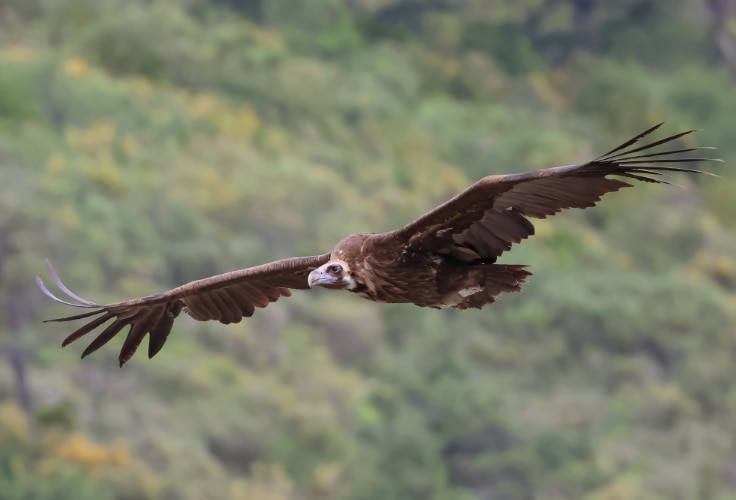
The species ranges from the Iberian Peninsula and the Balkans across Central Asia to Mongolia and northern China, occupying forested mountains, alpine steppe, and arid grasslands. It usually nests in large trees, building enormous stick platforms that are often reused for decades, though in Asia it may also nest on cliffs.
While recovering in parts of Europe, the cinereous vulture continues to decline in much of Asia. Main threats include poisoning, shooting, and exposure to veterinary drugs such as diclofenac, which have devastated vulture populations in South Asia. Habitat loss, dwindling carrion from livestock and wild ungulates, wind turbine collisions, and disturbance at nests further add to pressures. Conservation programs in Spain, France, and Greece, with measures such as supplementary feeding and reintroduction, have stabilized numbers locally, but without similar long-term investment across Central Asia the species remains at risk of steep decline in its core range.
California Condor
Gymnogyps californianus
- Wingspan: As wide as 3.05 m (10.0 ft).
- Weight: As heavy as 14 kg (30.9 lb).
- Body length: Up to 140 cm (55.1 in).
- Where found: Southwestern United States and Baja California, Mexico – in rugged canyons, scrublands, and montane forests.
- Conservation status: Critically Endangered.
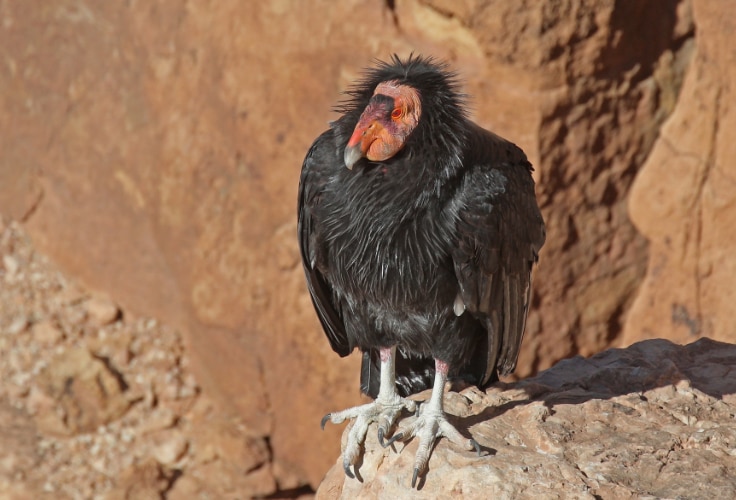
The California condor is the largest bird of prey in North America, and the continent’s biggest bird overall. With a wingspan stretching up to 3.05 meters (10.0 feet), it soars on thermal currents, sustained by long, broad wings with fingered tips that allow hours of effortless flight.
This condor feeds almost exclusively on carrion, ranging from deer and livestock to marine mammals along the Pacific coast. It locates food by watching other scavengers, such as turkey vultures and golden eagles, and once on the ground it usually dominates access to carcasses. Although soft tissue makes up most of its diet, condors also swallow bones to supplement calcium needs, showing a preference for medium-sized carcasses that are easier to penetrate.
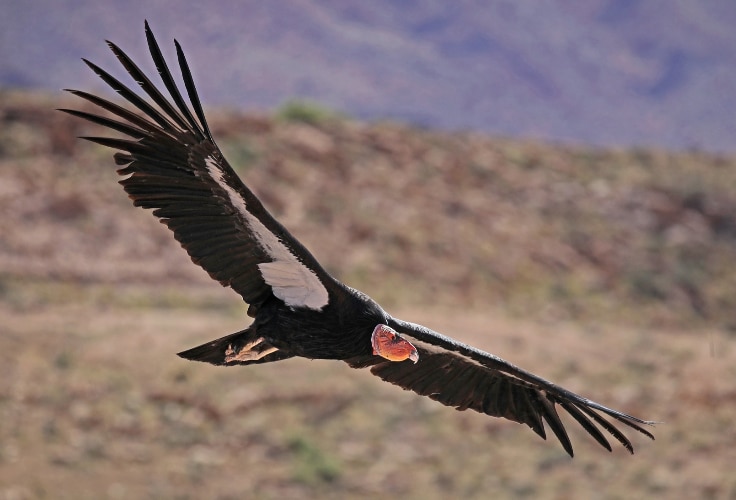
Historically widespread across much of North America, the species now survives in isolated populations in California, Arizona, Utah, and Baja California. It occupies rugged canyons, montane forests, and scrubland habitats, using cliff ledges or tall trees for roosting and nesting. Once absent from the wild entirely, it has been reintroduced through intensive captive-breeding programs, with the wild population reaching 369 individuals by 2025 and showing slow but steady expansion in its core strongholds.
Despite this progress, the California condor remains heavily dependent on conservation management. Lead poisoning from spent ammunition is the leading cause of death, while trash ingestion continues to threaten nestlings. Habitat loss, disturbance, and the species’ naturally slow reproduction further hinder recovery. Ongoing conservation measures include lead-free ammunition initiatives, supplemental feeding, nest monitoring, and captive-breeding support. Long-term survival depends on sustained human intervention and strict mitigation of threats.
Lappet-Faced Vulture
Torgos tracheliotos
- Wingspan: As wide as 2.9 m (9.5 ft).
- Weight: As heavy as 9.4 kg (20.7 lb).
- Body length: Up to 115 cm (45.3 in).
- Where found: Across sub-Saharan Africa and parts of the Middle East – in dry savannas, deserts, and arid plains.
- Conservation status: Endangered.
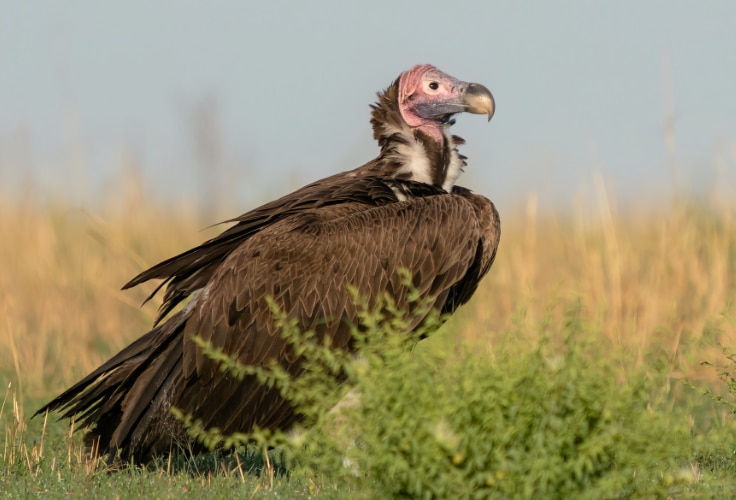
The lappet-faced vulture is Africa’s largest bird of prey, with a wingspan reaching 2.9 meters (9.5 feet) and huge individuals weighing up to 9.4 kilograms (20.7 pounds). Its massive, hooked beak is among the strongest of any vulture, able to tear through tough hides that other scavengers cannot penetrate, giving it first access to food. In flight, long, broad wings with low wing loading provide buoyant soaring and efficient searching over vast open landscapes.
While primarily a scavenger, the species shows more versatility than most vultures. It feeds on carcasses of all sizes, often swallowing skin and bone fragments and consuming over a kilogram (2.2 pounds) of food in a single meal. It occasionally hunts small vertebrates and has been observed group-hunting flamingo chicks, and it sometimes pirates food from other raptors. At large carcasses, gatherings of up to 50 birds may occur, where dominance displays often delay feeding before individuals return to tear into sinew and muscle with their powerful bills.
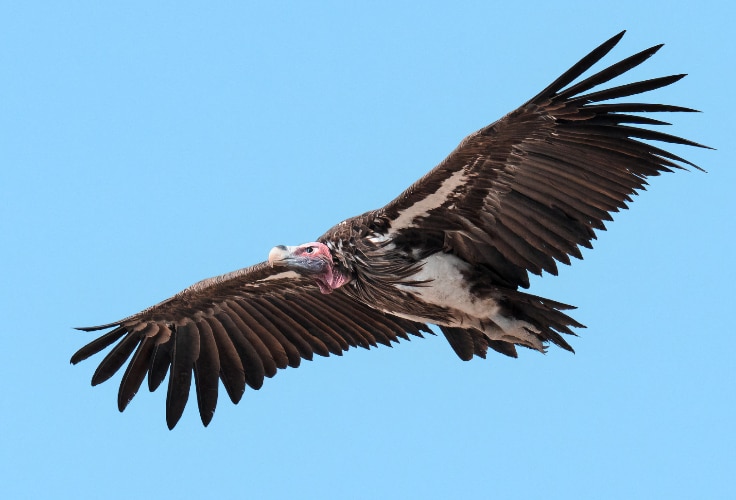
The species ranges sparsely across sub-Saharan Africa, the Arabian Peninsula, and the Sahel, inhabiting deserts, dry savannas, and arid plains. Formerly widespread, it has disappeared from much of North and West Africa and now survives in fragmented populations. Though it forages widely, it nests solitarily in large trees such as acacias, typically raising a single chick per breeding attempt.
The lappet-faced vulture is undergoing a severe and continuing decline. Major threats include poisoning, both targeted and accidental, direct persecution, disturbance at nest sites, and exploitation for traditional medicine. While the species still breeds in reserves such as Kruger National Park in South Africa and protected areas in Saudi Arabia, its global population has plummeted in recent decades. Conservation initiatives now focus on poison-response teams, community education, protection of nest sites, and stronger enforcement against wildlife trafficking.
Wedge-Tailed Eagle
Aquila audax
- Wingspan: As wide as 2.84 m (9.3 ft).
- Weight: As heavy as 5.8 kg (12.8 lb).
- Body length: Up to 106 cm (41.7 in).
- Where found: Australia, Tasmania, southern New Guinea – in a wide range of habitats.
- Conservation status: Least Concern.
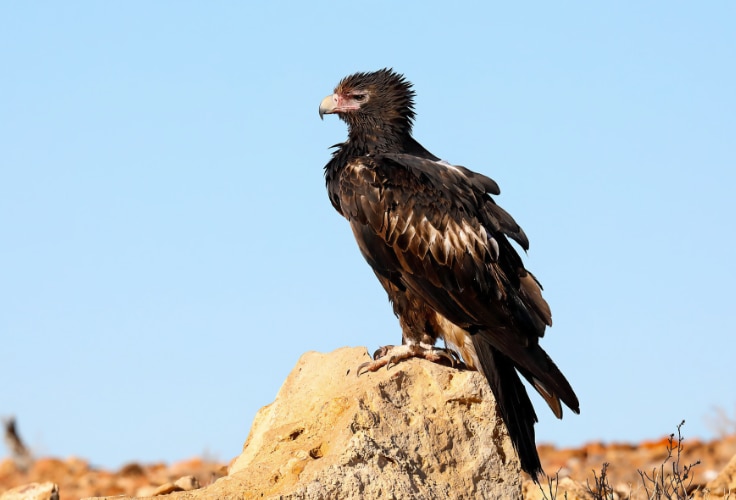
The wedge-tailed eagle is the largest bird of prey in Australia, reaching a body length of 106 centimeters (41.7 inches) and a weight of up to 5.8 kilograms (12.8 pounds). The Tasmanian population includes the biggest individuals, with wingspans stretching to 2.84 meters (9.3 feet), the widest verified among eagles. This eagle is built for soaring and is easily recognized by its long wedge-shaped tail, broad wings, and shaggy feathered legs.
Riding thermals for hours with barely a wingbeat, it uses sharp eyesight to locate prey or carrion from great heights. The diet is broad, ranging from rabbits, hares, and young kangaroos to birds, reptiles, and livestock, with carrion especially important outside the breeding season. Its dominance at carcasses often displaces smaller scavengers, and it occasionally pirates food from other raptors. Most strikingly, pairs or groups have been recorded coordinating attacks on adult kangaroos, a rare feat that underscores the species’ strength and cooperative hunting ability.
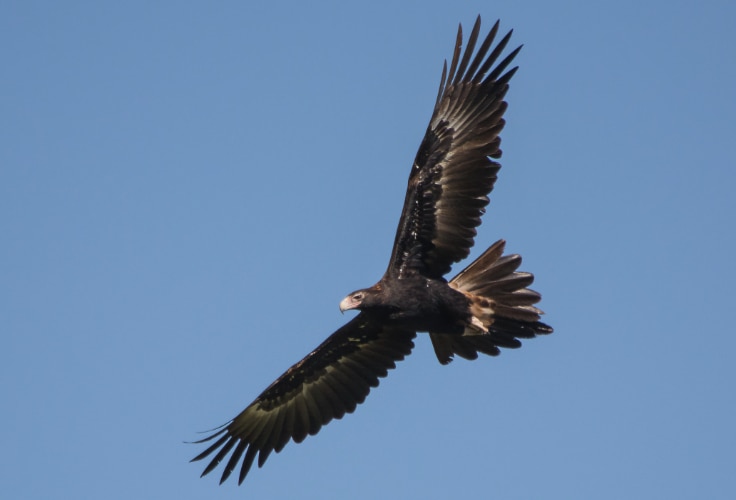
The wedge-tailed eagle is widespread across mainland Australia, Tasmania, and southern New Guinea. It occupies an exceptionally broad range of habitats, from open woodlands and arid grasslands to savannas, montane forests, and semi-deserts. While it avoids dense forests and heavily developed areas, it remains highly adaptable and is a familiar sight gliding over remote or lightly wooded landscapes.
The species was once heavily persecuted, with tens of thousands killed under government bounty schemes through much of the 20th century. Despite this, it proved remarkably resilient. Legal protection has since allowed populations to rebound, and they are now stable or increasing across much of the range. Ongoing threats include habitat clearance, collisions with vehicles and power lines, poisoning, and persecution, with the Tasmanian subspecies facing particular pressure and considered endangered.
Secretarybird
Sagittarius serpentarius
- Wingspan: As wide as 2.15 m (7.1 ft).
- Weight: As heavy as 4.3 kg (9.5 lb).
- Body length: Up to 150 cm (59.1 in).
- Height: As tall as 1.3 m (4.3 ft).
- Where found: Sub-Saharan Africa – in open grasslands, savannas, shrublands, and semi-arid plains.
- Conservation status: Endangered.

The secretarybird is the world’s tallest and longest bird of prey, standing up to 1.3 meters (4.3 feet) tall and measuring up to 1.5 meters (59.1 inches) in length. It is unmistakable on the African plains, its profile defined by elongated, crane-like legs and a striking crest of black feathers.
These long legs are highly specialized weapons. The bird delivers rapid kicks with a force several times its own body weight, powerful enough to kill snakes, lizards, and small mammals in milliseconds. Its diet, however, is broad and includes grasshoppers, beetles, rodents, hares, birds, and even tortoises or crabs. Prey is usually swallowed whole, but larger animals are torn apart with the bill while pinned under the feet. Snakes may be seized and dropped from the air or stamped to death, and the species is often seen hunting near grass fires to seize fleeing or dead prey.
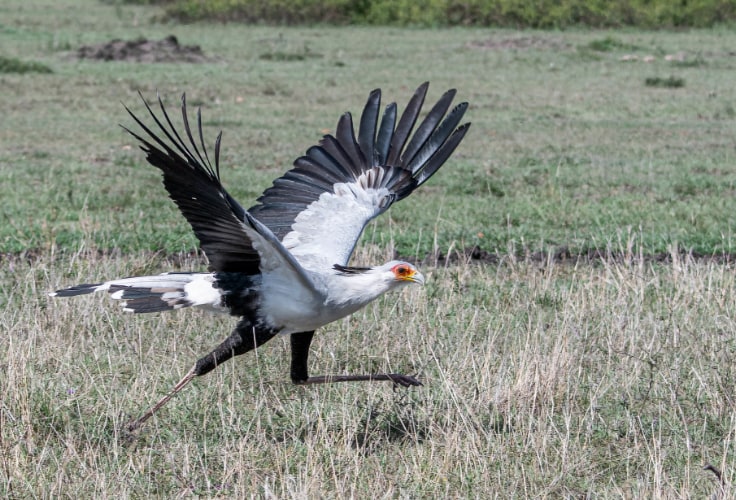
Though capable of soaring to high altitudes, it relies primarily on the ground to hunt, walking more than 30 kilometers (19 miles) a day with measured, high-stepping strides. When pursuing prey, it may break into a sprint, reaching speeds of up to 32 km/h (20 mph) and often spreading its wings for balance – a behavior seen in other fast-running birds.
The secretarybird ranges widely across sub-Saharan Africa, inhabiting grasslands, savannas, and lightly wooded plains where low vegetation allows clear visibility. It usually hunts alone or in pairs, striding with deliberate, high-stepping movements, sometimes spreading its wings for balance while running.
Despite its wide distribution, the species is undergoing a steep decline. Habitat loss from agriculture, overgrazing, and urban expansion has reduced suitable hunting grounds, while power line collisions, electrocution, and poisoning further threaten survival. Conservation measures focus on protecting habitat, monitoring populations, and reducing human-caused mortality, but the bird’s future remains precarious across much of its former range.
Steller’s Sea Eagle
Haliaeetus pelagicus
- Wingspan: As wide as 2.7 m (8.9 ft).
- Weight: As heavy as 9.5 kg (20.9 lb).
- Body length: Up to 105 cm (41.3 in).
- Where found: Russian Far East; winters in Japan and the southern Kurils – in coastal cliffs, large rivers, and inland lakes.
- Conservation status: Vulnerable.
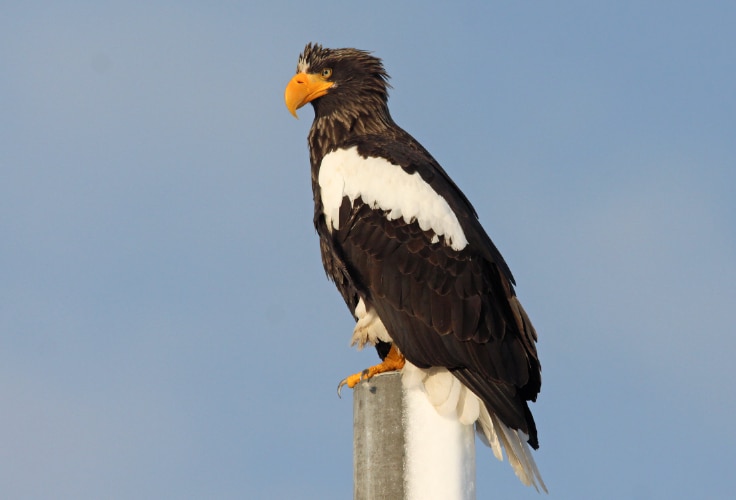
The Steller’s sea eagle is one of the most powerfully built raptors, with large females reaching 9.5 kilograms (20.9 pounds) and wingspans up to 2.7 meters (8.9 feet). While not the absolute record-holder for mass or wingspan, its large average size and overall bulk place it among the biggest eagles in the world.
Its barrel-shaped body, wedge-shaped tail, and striking plumage make it instantly recognizable. The oversized, deep yellow bill is one of the largest among raptors and is well adapted for tearing into fish and carcasses. In flight, its broad, slotted wings and heavy wingbeats give it a stately, deliberate presence over coasts and river valleys.

Fish dominate the diet, especially Pacific salmon taken alive or dead, though pollock becomes critical in Japanese wintering grounds. It also scavenges from seal carcasses, wildfowl, and deer remains, and occasionally preys on birds or small mammals such as hares or Arctic foxes. Hunting techniques include swooping from perches along rivers, circling low over water before plunging feet-first, or standing on sandbanks, ice, or shallow edges to seize prey. During breeding, food demand rises sharply, with adults delivering large fish and carcass portions to their chicks.
The species breeds along the coasts and riverine forests of eastern Russia, especially Kamchatka, Sakhalin, and the Sea of Okhotsk. Pairs build large nests in tall trees or occasionally on cliffs, usually near productive waters. Most migrate south in winter to Hokkaido, Japan, or the southern Kuril Islands, where they concentrate at coastal sites rich in fish and carrion.
Steller’s sea eagles face multiple threats, including industrial development, logging, and hydroelectric projects that reduce breeding habitat. Overfishing depletes key food sources, while lead poisoning from scavenged carcasses contaminated with ammunition remains a major cause of mortality. Despite legal protection and close monitoring, the species remains highly vulnerable due to its limited range. Conservation measures focus on habitat protection, reducing industrial pollution, and eliminating toxic ammunition to safeguard this giant of the North Pacific.
Blakiston’s Fish-Owl
Ketupa blakistoni
- Wingspan: As wide as 2.0 m (6.6 ft).
- Weight: As heavy as 4.6 kg (10.1 lb).
- Body length: Up to 72 cm (28.3 in).
- Where found: Russian Far East, northeastern China, and Hokkaido, Japan – in riverine forests with unfrozen streams and large nesting trees.
- Conservation status: Endangered.

The Blakiston’s fish-owl is the largest living owl by both wingspan and body mass. It reaches 4.6 kilograms (10.1 pounds) in weight and a wingspan of 2 meters (6.6 feet), rivaling small eagles in overall bulk. With broad, heavily feathered wings, a shaggy plumage, and fully feathered feet, it is built for insulation and silent flight along snowy river valleys. Its broad facial disc enhances hearing, and its immense talons allow it to seize slippery aquatic prey with precision.
This owl specializes in fishing. It hunts mainly at night from low perches along rivers, swooping down to snatch salmon and other fish from shallow water, or plunging feet-first near the surface. It also stalks frogs, crayfish, and waterfowl, occasionally taking mammals or even domestic animals such as cats and small dogs. Birds up to the size of grouse have been recorded as prey. In winter, it may wait beside openings in frozen rivers and streams, sometimes in loose groups of several individuals.

Its range includes the Russian Far East, northeastern China, and Japan’s Hokkaido, where it inhabits mature riverine forests with unfrozen channels, springs, and lake margins. It nests in large tree cavities, often in ancient poplars or other old-growth trees, and its slow reproduction and long lifespan heighten its sensitivity to habitat loss.
The species faces numerous threats, including logging of old-growth nesting sites, dam construction, riverbank development, and declining fish stocks. In Japan, additional hazards include collisions with power lines, drowning in fish-farm nets, and inbreeding in small, isolated populations. Conservation efforts involve nest box programs, protection of key breeding areas, and cooperation with forestry companies to minimize disturbance. Despite these measures, much of its optimal habitat remains unprotected, leaving its future uncertain as one of the world’s most endangered owls.
Red Kite
Milvus milvus
- Wingspan: As wide as 1.95 m (6.4 ft).
- Weight: As heavy as 1.6 kg (3.5 lb).
- Body length: Up to 72 cm (28.3 in).
- Where found: Across Europe – in woodlands, pastures, and farmland.
- Conservation status: Least Concern.
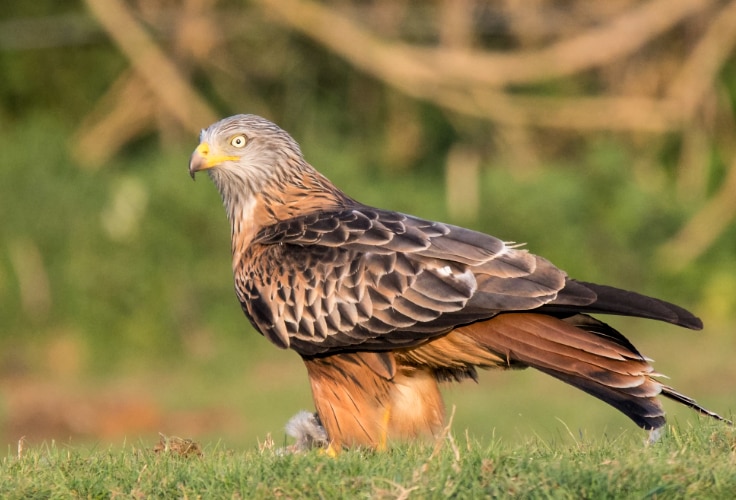
The red kite is the largest of the world’s kites, a slender and elegant raptor instantly recognized by its long forked tail, chestnut plumage, and deeply notched wings. With a wingspan reaching 1.95 meters (6.4 feet), it soars with slow, buoyant wingbeats and wide glides, often twisting its tail to steer with precision.
Adapted for opportunism rather than brute force, it feeds on carrion, roadkill, and waste, but also hunts small mammals, birds, and occasionally reptiles or amphibians. Its light build and aerial agility allow it to swoop down from soaring flight or quarter low over open fields in search of prey. Red kites are frequently seen scavenging near farmland, rubbish tips, and even gardens, sometimes gathering in groups at abundant food sources.
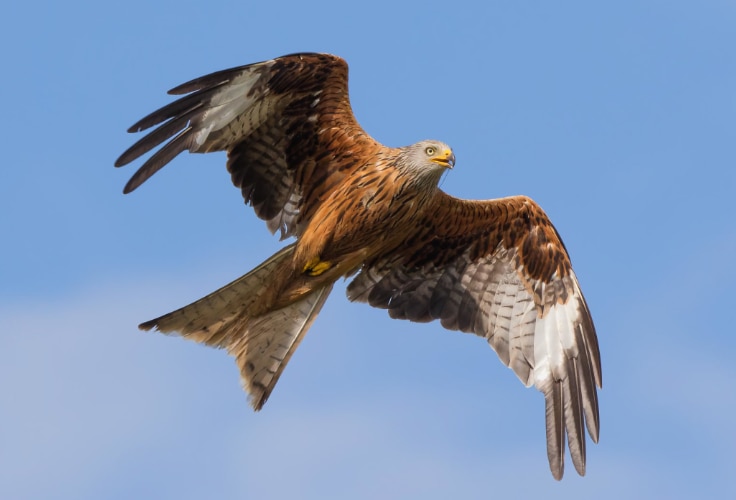
Endemic to the western Palearctic, the species breeds across much of Europe, from the Iberian Peninsula and the U.K. to Ukraine and southern Scandinavia. It favors broadleaf woodlands near open countryside, using trees for nesting while hunting over pastures and croplands. Northern populations are largely resident, while those in central and eastern Europe migrate south in winter.
Once severely reduced by persecution and pesticides, the red kite has staged a remarkable recovery through legal protection and reintroduction programs, especially in the UK and central Europe. Despite this success, illegal poisoning, persecution, and changing land use still threaten some populations, with localized declines persisting in parts of southern Spain and Portugal.
Snowy Owl
Bubo scandiacus
- Wingspan: As wide as 1.83 m (6.0 ft).
- Weight: As heavy as 2.95 kg (6.5 lb).
- Body length: Up to 71 cm (28.0 in).
- Where found: Arctic tundra across North America and Eurasia.
- Conservation status: Vulnerable.
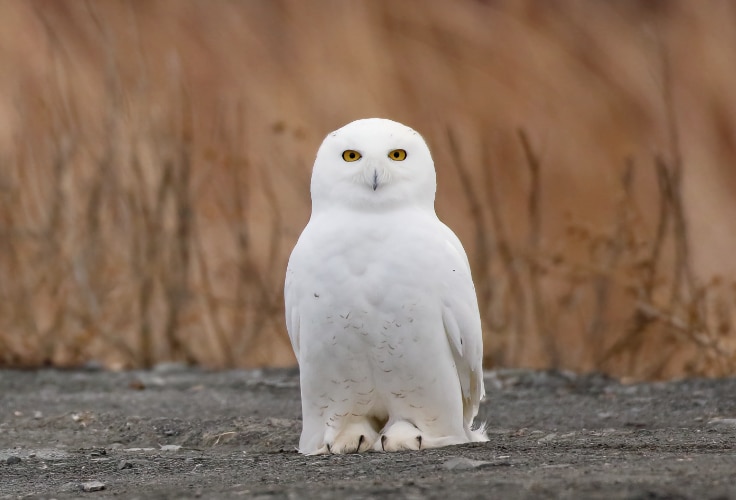
The snowy owl is the largest and most powerful raptor of the High Arctic, dominating some of the northernmost ecosystems inhabited by any bird of prey. Females, which are larger than males, can weigh up to 2.95 kilograms (6.5 pounds), with wingspans reaching 1.83 meters (6 feet). Its dense white plumage, broad rounded head, and piercing yellow eyes make it instantly recognizable as it scans the tundra from a perch or in silent, low flight.
This owl is highly specialized for life in the Arctic. It depends heavily on lemmings and voles during the breeding season, when large broods can only be raised in areas with high rodent densities. At other times, it hunts a wide range of prey including waterfowl, seabirds, hares, and grouse, and will scavenge carrion such as seal, caribou, or polar bear kills when available. Opportunism is key to survival in its harsh environment, and individuals concentrate where local prey is most abundant, whether inland grasslands, coastal marshes, or even offshore ice leads rich in sea ducks.

The snowy owl breeds across Arctic tundra from Alaska and northern Canada to Greenland, Scandinavia, and Russia, nesting on ridges or hummocks with open views. Highly nomadic, it moves in response to prey cycles, with irruptions sometimes carrying large numbers far south into temperate regions. Though capable of hunting at any hour, it is especially active during dawn and dusk, and in the 24-hour summer light of the Arctic, activity shifts to the dimmest parts of the day.
Despite legal protection, the species faces growing threats. Vehicle collisions, electrocution, and secondary poisoning cause frequent mortality, while climate change alters snow cover and disrupts rodent cycles, undermining breeding success. Population declines are ongoing, leaving the snowy owl increasingly vulnerable in its fragile Arctic ecosystems.
Upland Buzzard
Buteo hemilasius
- Wingspan: As wide as 1.61 m (5.3 ft).
- Weight: As heavy as 2 kg (4.4 lb).
- Body length: Up to 72 cm (28.3 in).
- Where found: Central and East Asia, including Mongolia, China, and southern Siberia – in alpine meadows, upland steppes, plateaus, and rocky grasslands.
- Conservation status: Least Concern.
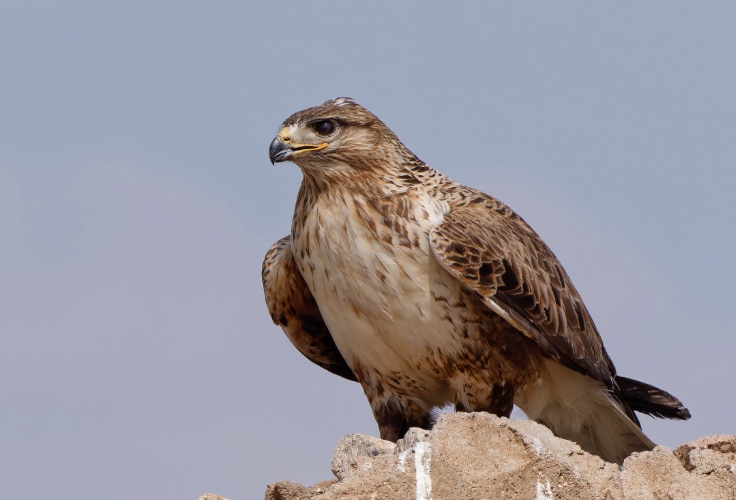
The upland buzzard is the largest of the Buteo hawks by both length and wingspan. It reaches 72 centimeters (28.3 inches) in body length, with wingspans up to 1.61 meters (5.3 feet), and large females can surpass 2 kilograms (4.4 pounds). This broad-winged raptor is adapted to soaring over vast upland landscapes, often circling high on thermals or hovering in place as it scans for prey across grasslands and plateaus.
Rodents form the bulk of its diet, particularly ground squirrels, voles, gerbils, pikas, and young marmots, though it also takes young hares, birds such as larks or grouse, and occasionally eggs, amphibians, or insects. It hunts by soaring or by scanning from rocky perches, dropping swiftly onto prey. Seasonal rodent fluctuations strongly influence breeding success and local abundance, with birds sometimes gathering in areas of high prey density.
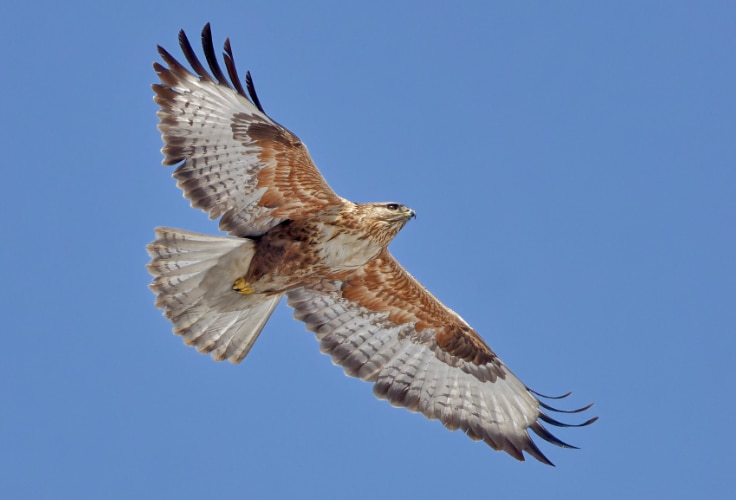
Its breeding range covers Mongolia, northern China, and parts of southern Siberia, with smaller populations scattered across Central Asia. The species nests on rocky outcrops or cliffs, foraging widely over alpine meadows, steppe, and sometimes agricultural fields. A partial migrant, it shifts elevation or makes short seasonal movements to avoid snow cover.
Although generally scarce across much of its range, the upland buzzard can be locally common where rodents are abundant, especially in Mongolia and southern Siberia. The species is not considered globally threatened, but localized risks include grassland degradation, electrocution on power lines, and accidental entrapment in cisterns.
Gyrfalcon
Falco rusticolus
- Wingspan: As wide as 1.6 m (5.2 ft).
- Weight: As heavy as 2.6 kg (5.7 lb).
- Body length: Up to 65 cm (25.6 in).
- Where found: Arctic and sub-Arctic regions of North America, Europe, and Asia – in tundra, sea ice, and coastal cliffs.
- Conservation status: Least Concern.
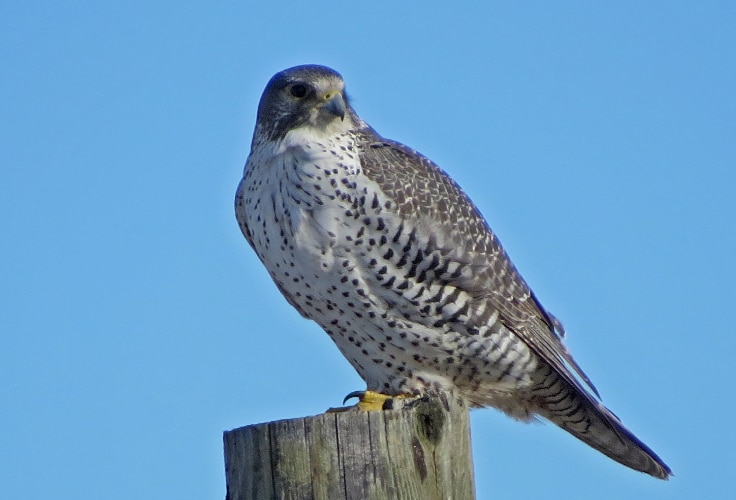
The gyrfalcon is the largest falcon in the world and a formidable predator of Arctic and sub-Arctic landscapes. With a wingspan reaching 1.6 meters (5.2 feet) and a maximum weight of 2.6 kilograms (5.7 pounds), it surpasses all other falcons in size and muscular build.
Unlike the smaller peregrine, famed for its plunging stoops, the gyr relies on sheer power and endurance. It often hunts by sustained horizontal chases, flying low and fast over open tundra until it forces prey to the ground or exhausts it in flight. Despite its bulk, it is still among the fastest birds in level pursuit.
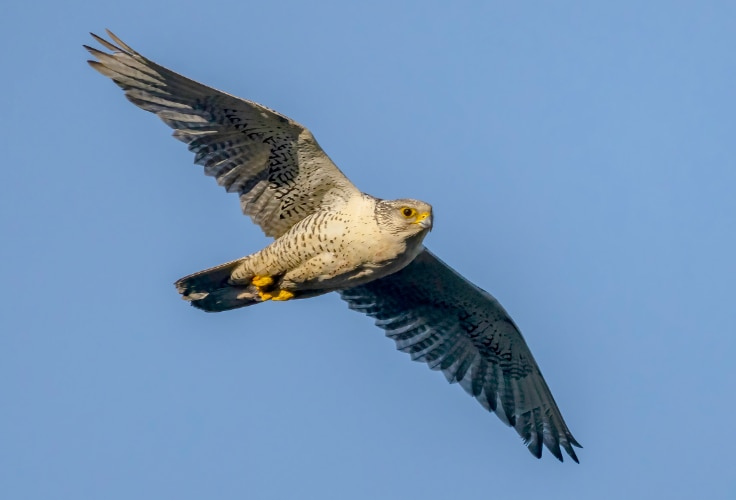
This falcon preys mainly on birds, especially ptarmigan, grouse, seabirds, and waterfowl, but will also take mammals such as hares and voles. Hunts are carried out in varied ways: surprise ground attacks using terrain for cover, long tail-chases over open land, or short stoops to flush prey from cover. It sometimes soars along ridges like an eagle, hovers briefly over prey, or ascends steeply to gain altitude on lighter-winged birds. Kills are often dispatched on the ground, and immatures occasionally pirate food from other raptors.
The gyrfalcon ranges across Arctic and sub-Arctic landscapes, breeding on cliffs and rocky outcrops in tundra and coastal areas of North America, Greenland, and Eurasia. Though mostly sedentary, individuals may disperse widely outside the breeding season, with some moving onto sea ice or southward in years of prey scarcity.
While the global population remains stable, the species faces pressures from illegal trapping for falconry, nest disturbance, overharvest of prey, and climate change affecting Arctic ecosystems. In Russia, oil industry expansion has opened remote areas to poaching, while pollutants accumulate in birds feeding heavily on seabirds. Still, many breeding sites remain remote and difficult to access, offering natural protection for this powerful symbol of the far north.
Crested Caracara
Caracara plancus
- Wingspan: As wide as 1.32 m (4.3 ft).
- Weight: As heavy as 1.6 kg (3.5 lb).
- Body length: Up to 65 cm (25.6 in).
- Where found: Southern U.S. to southern South America – in open savannas, grasslands, deserts, scrublands, and farmland.
- Conservation status: Least Concern.

The crested caracara is the largest of all living caracaras and one of the most distinctive members of the falcon family. With a heavy-set build, long legs, and a wingspan reaching 1.32 meters (4.3 feet), it contrasts sharply with the sleek, high-speed hunters of the Falco genus. Size varies across its range, with individuals from cooler southern regions averaging larger than their tropical counterparts.
This species is highly opportunistic. While it is most conspicuous feeding on carrion, it also hunts a wide array of live prey including mammals, birds and their eggs, reptiles, amphibians, fish, and insects. It often forages on foot, walking with deliberate strides while scanning the ground, or patrols roads and fields in low flight to locate prey and roadkill. It will wade in shallow water to catch aquatic animals, raid nests, plunder colonies of waterbirds, or even consume fruit in some parts of its range. Though less aerial than most falcons, it often associates with vultures at carcasses and has been recorded pirating food or engaging in mutual preening with black vultures.
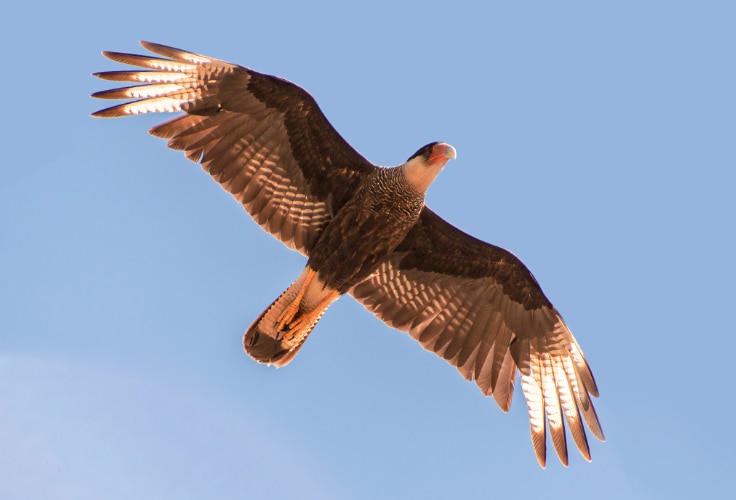
The crested caracara is widespread across the Americas, from the southern United States to Tierra del Fuego. It thrives in open and semi-open habitats, including savannas, scrublands, deserts, and farmlands, and readily adapts to human-altered landscapes such as pastures, dumps, and fields. Bold and conspicuous, it is often seen walking across open terrain, perched on fence posts, or following fires, vehicles, or farming equipment in search of food.
The species benefits from its adaptability and remains widespread and stable. Local threats include pesticide use, collisions, and occasional trapping, but its ability to exploit a wide range of food sources and habitats has allowed it to flourish where many other raptors have declined.
Swamp Harrier
Circus approximans
- Wingspan: As wide as 1.45 m (4.8 ft).
- Weight: As heavy as 1.1 kg (2.4 lb).
- Body length: Up to 62 cm (24.4 in).
- Where found: Across New Zealand, Australia, and the south-west Pacific islands – in wetlands and open country.
- Conservation status: Least Concern.
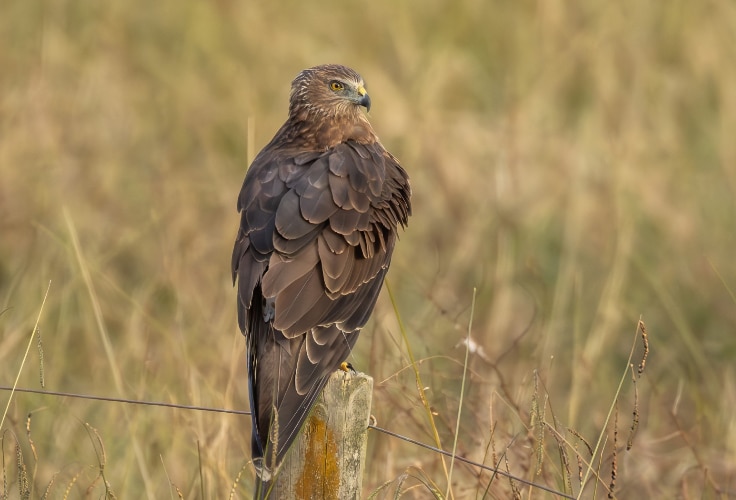
The swamp harrier is the largest of all harriers, a familiar sight gliding low across wetlands and farmlands in Australasia. With a wingspan of 1.45 meters (4.8 feet), it cuts a broad-winged silhouette as it quarters slowly over open country with wings held in a shallow V-shape. Its pale rump patch, owl-like facial disc, and long legs make it easily identifiable in flight.
This raptor is adapted to hunting in open habitats, where it relies on deliberate quartering flight, sudden plunges, or harrying pursuits. It takes a wide variety of prey, including rabbits, small mammals, birds, reptiles, amphibians, and large insects, and it also feeds heavily on carrion, especially in New Zealand. Harriers are known to drown waterbirds such as coots and small ducks, or to exhaust them through repeated chases. Seabirds can be an important food source in some regions, and the species will also wade into shallow water for frogs or aquatic invertebrates. Opportunistic by nature, it occasionally robs other raptors at their kills.
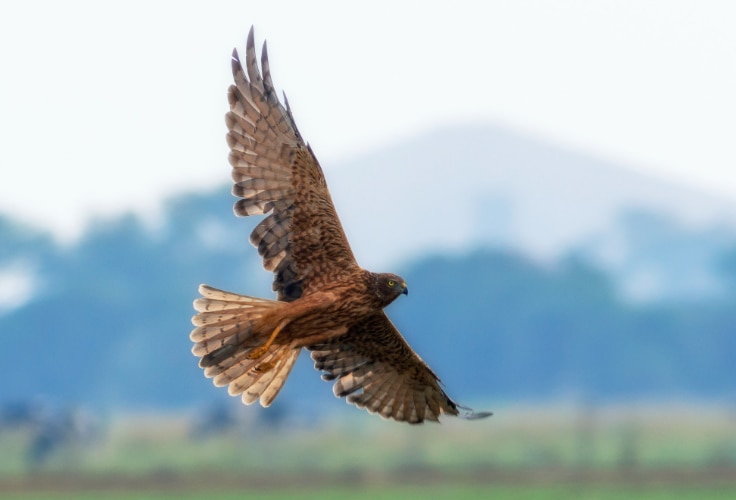
The swamp harrier is widespread across New Zealand, much of Australia, and islands of the southwest Pacific, from the Kermadecs to Campbell Island. It thrives in open habitats including marshes, pastures, scrublands, and agricultural fields, and in New Zealand it expanded greatly following forest clearance and farmland development.
Though sometimes persecuted, the species remains locally abundant and adaptable. It is also notable as the only bird of prey legally used in falconry in New Zealand. Overall, populations are stable, and the swamp harrier remains a common and conspicuous raptor across its range.
Largest Predatory Bird That Ever Lived
While the birds in this list represent the largest living raptors, prehistoric skies were once ruled by even more imposing predators. Among them was Argentavis magnificens, a giant teratorn from Miocene South America. This bird, now considered the heaviest flying species ever known, reached a wingspan of up to 6 meters (19.7 feet), stood about 2 meters (6.6 feet) tall, and may have weighed as much as 80 kilograms (176.4 pounds). Living around six million years ago in what is now Argentina, Argentavis soared over open plains and foothills, likely using thermal currents much like modern condors.

